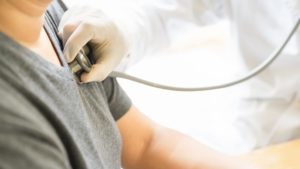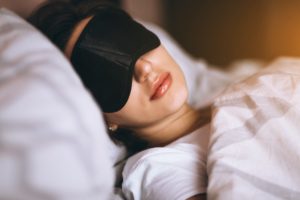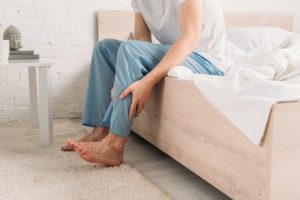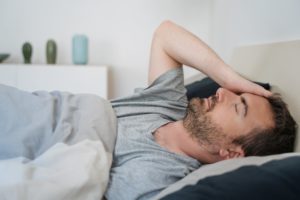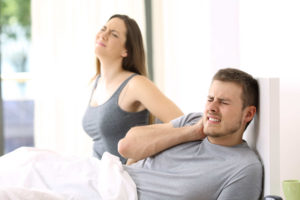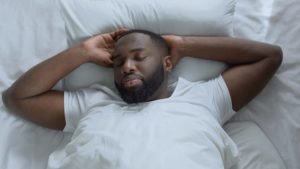Sciatic Nerve Pain Relief at Night
Sciatica broadly refers to pain, tingling, or other discomfort along a sciatic nerve. Each sciatic nerve runs from the lower back and pelvis down the back side of the leg and into the feet. As a result, a person with sciatica may experience pain or other sensations in the lower back, leg, or even foot. If unaddressed, pain triggered by sciatica can lead to poor or insufficient sleep.
What Is Sciatica?
Sciatica is pain or other uncomfortable feelings in the lower back, legs, or feet caused by a problem with a sciatic nerve or sciatic nerve roots . A person may develop sciatica if a sciatic nerve is irritated, compressed, or damaged.
The sciatic nerves are the body’s two longest and thickest nerves. Each runs from the lower back to the foot and is nearly the width of a finger. The sciatic nerves are responsible for providing feeling in several parts of the leg and foot and controlling muscles behind the knee and in the lower leg.
Although some people may use the term sciatica to refer to any pain in the back or legs, sciatica is pain that specifically comes from the sciatic nerve. Sciatica commonly causes lower back pain, but only about 5% of people who report pain in the lower back have sciatica.
Typically, sciatica affects adults over 20 years old. People in their 40s are most likely to experience the disorder. Limited research suggests that a person’s genetics may affect their likelihood of developing sciatica.
Research on the frequency of sciatica by gender is mixed. Some evidence suggests men aged 30 to 50 have a higher chance for the disorder, while other evidence shows no difference between genders.

Symptoms of Sciatica
Symptoms of sciatica vary but usually occur on one side of the body along the sciatic nerve. Common symptoms of sciatica include:
- Pain
- Numbness
- Tingling
- Aching
- Burning
- Weakness
These sensations may occur in a number of regions. People with sciatica commonly report pain in the lower back, which includes muscles and nerves at the base of the spine . Sciatica often causes pain or a sensation of burning in the buttocks and may also cause pain in the hips, calves, soles of the feet, and toes. In some cases of sciatica, one leg may feel unusually weak or heavy, causing a person to trip while walking.
A person with sciatica may feel different uncomfortable sensations at the same time, such as numbness in one part of the leg and pain in another.
Causes of Sciatica
Sciatica is caused by compression, irritation, or other damage to the sciatic nerve. In some cases, health care providers cannot identify the source of sciatica. However, a number of conditions can trigger sciatica.
- Slipped, bulging, or herniated disk: A protruding or ruptured spinal disk is a top cause of sciatica. If one of the soft disks in between each bone along the spine leaks or breaks open, it can irritate the sciatic nerve. Heavy lifting or sitting in the same position for too long can lead to a slipped disk.
- Spinal stenosis: Commonly caused by arthritis of the spine, spinal stenosis makes the backbone become narrow. When the backbone narrows, it can compress the sciatic nerve. Typically, spinal stenosis occurs in adults over 60 years old.
- Pelvic fracture or injury: A person can injure or break a pelvic by playing sports or through falls and other accidents. A pelvic fracture may affect the sciatic nerve roots in the lower spine, leading to sciatica.
- Osteoarthritis: Osteoarthritis wears down cartilage at joints throughout the body, including the lower back and hips. As a result, the bone may develop a lump that can affect the sciatic nerve.
- Spinal tumor or blood clot: In rare cases, a tumor or mass of blood can press on the sciatic nerve and cause pain.
Certain behaviors may worsen sciatica, such as bending the spine, holding your breath, standing for a long time, or sudden movements like coughing, sneezing, or laughing.
What Is the Best Sleeping Position for Sciatica Pain?
Research is limited on the best position to sleep in specifically to relieve sciatic nerve pain. The best way to sleep with sciatica can depend on the individual and may require trying different sleeping positions to find the one that is most comfortable.
For some people with sciatica, sleeping on one side may relieve their back pain. Experts recommend that side sleepers with back pain bend the top knee and place a pillow between the knees. If the person with sciatica and back pain prefers sleeping on their back, a pillow under their knees can reduce pressure on the back.
If the person with sciatica has difficulty finding a comfortable sleep position, or if they have trouble sleeping because of sciatica pain, they should talk with their health care provider.
How to Sleep With Sciatica
For some people, sciatic nerve pain may resolve without treatment. However, some at-home management steps and lifestyle changes may help improve sciatica for people whose symptoms do not go away on their own.
- Use cold and heat for pain relief: Cold and hot packs can reduce inflammation and provide comfort at the painful area. Experts recommend using ice during the first two or three days of pain, then using heat.
- Use pain relievers short-term: Over-the-counter pain relievers can reduce sciatica symptoms when used for a short period of time.
- Avoid triggering activities: Excessive sitting or standing in one position can cause sciatica to flare up. Adjusting your office chair or car seat could help you avoid making the pain worse. You may also rearrange items in the home for ease of access, such as moving objects from low cupboards to waist-level counters or higher cabinets.
- Continue light exercise: Experts recommend reducing activity levels following the initial onset of sciatica pain. However, they also recommend gentle forms of exercise, such as swimming or walking.
- Try strengthening exercises and stretches: Perform exercises that strengthen the back and the core. Gently stretch the lower back muscles and hamstrings.
- Limit bed rest: Avoid spending too much time in bed, even if you are in pain. People with lower back pain who stay active recover more quickly.
Scientific research on the best mattress for sciatica pain relief is limited. But people with sciatica who struggle to get comfortable at night may also consider whether their current mattress meets their needs. Because people with sciatica have pain in the lower back or hips, they may need a mattress that supports these pressure points and keeps the spine correctly aligned.
Researchers have conducted some studies on mattresses for back pain, with somewhat mixed results. In one review of studies regarding the best mattresses for back pain, researchers concluded that a medium-firm mattress improves sleep quality and reduces the risk of developing back pain. By contrast, a few small studies have found that a softer mattress or a mattress that conforms to the back can relieve back pain.
When to See a Doctor
If at-home methods do not relieve your sciatica pain, or if the pain interferes with your sleep and day-to-day life, contact your health care provider. A doctor can evaluate your symptoms, identify potential causes of the pain, confirm a sciatica diagnosis, and develop a treatment plan.
Typically, a doctor first tests your reflexes, strength, and ability to sense feeling, in order to confirm that you have sciatica. Then, if you have experienced the pain for six to eight weeks, a doctor may perform imaging, such as a CT scan or MRI. These types of imaging help the doctor determine if something abnormal in the spine is causing the sciatica.
Your health care provider may recommend additional medical treatments for sciatica. These might include muscle relaxants, prescription pain relievers, and local injections for pain relief. They may also recommend that you consult with a physical therapist, receive a deep tissue massage, or try acupuncture. In some infrequent cases, they may recommend surgery.
Medical Disclaimer: The content on this page should not be taken as medical advice or used as a recommendation for any specific treatment or medication. Always consult your doctor before taking a new medication or changing your current treatment.

Still have questions? Ask our community!
Join our Sleep Care Community — a trusted hub of sleep health professionals, product specialists, and people just like you. Whether you need expert sleep advice for your insomnia or you’re searching for the perfect mattress, we’ve got you covered. Get personalized guidance from the experts who know sleep best.
References
12 Sources
-
Moley, P. J. (2022, October). Sciatica. Merck Manual Consumer Version., Retrieved December 5, 2022, from
https://www.merckmanuals.com/home/bone,-joint,-and-muscle-disorders/low-back-and-neck-pain/sciatica -
A.D.A.M. Medical Encyclopedia. (2020, July 25). Sciatica. MedlinePlus., Retrieved December 5, 2022, from
https://medlineplus.gov/ency/article/000686.htm -
Sassack, B. & Carrier, J. D. (2022, August 25). Anatomy, back, lumbar spine. In StatPearls. StatPearls Publishing., Retrieved December 5, 2022, from
https://www.ncbi.nlm.nih.gov/books/NBK557616/ -
MedlinePlus: National Library of Medicine (US). (2016, October 18). Herniated disk., Retrieved December 5, 2022, from
https://medlineplus.gov/herniateddisk.html -
Levin, K. (2019, December 18). Lumbar spinal stenosis: Pathophysiology, clinical features, and diagnosis. In M. J. Aminoff & S. J. Atlas (Eds.). UpToDate., Retrieved December 5, 2022, from
https://www.uptodate.com/contents/lumbar-spinal-stenosis-pathophysiology-clinical-features-and-diagnosis -
Davis, D. D., Foris, L. A., Kane, S. M., & Waseem, M. (2022, August 17). Pelvic fracture. In StatPearls. StatPearls Publishing., Retrieved December 5, 2022, from
https://www.ncbi.nlm.nih.gov/books/NBK430734/ -
MedlinePlus: National Library of Medicine (US). (2022, February 23). Osteoarthritis., Retrieved December 5, 2022, from
https://medlineplus.gov/osteoarthritis.html -
Moley, P. J. (2022, October). Sciatica. Merck Manual Professional Version., Retrieved December 5, 2022, from
https://www.merckmanuals.com/professional/musculoskeletal-and-connective-tissue-disorders/neck-and-back-pain/sciatica -
Chou, R. (2021, September 20). Patient education: Low back pain in adults (Beyond the basics). In J. G. Elmore (Ed.). UpToDate., Retrieved December 5, 2022, from
https://www.uptodate.com/contents/low-back-pain-in-adults-beyond-the-basics -
A.D.A.M. Medical Encyclopedia. (2020, August 13). Taking care of your back at home. MedlinePlus., Retrieved December 5, 2022, from
https://medlineplus.gov/ency/article/002119.htm -
A.D.A.M. Medical Encyclopedia. (2020, August 13). Managing your chronic back pain. MedlinePlus., Retrieved December 5, 2022, from
https://medlineplus.gov/ency/patientinstructions/000516.htm -
Chou, R. (2022, August 2). Subacute and chronic low back pain: Nonpharmacologic and pharmacologic treatment. In S. J. Atlas (Ed.). UpToDate., Retrieved December 5, 2022, from
https://www.uptodate.com/contents/subacute-and-chronic-low-back-pain-nonpharmacologic-and-pharmacologic-treatment











